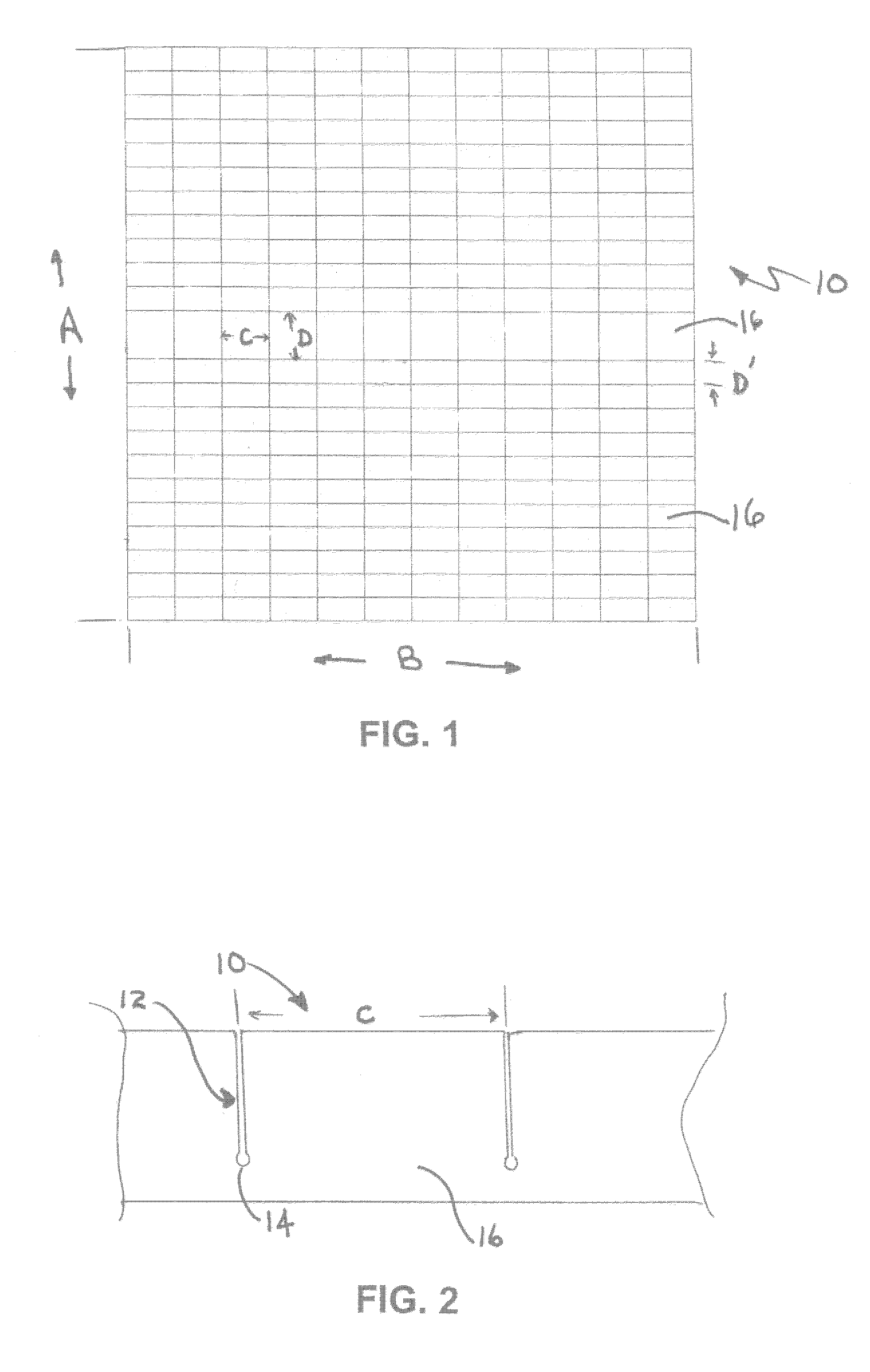Readily configurable plastic foam packaging
a flexible, plastic foam technology, applied in the field of packaging materials, can solve the problems of difficult disposal, inefficient storage and transportation of materials before use, and large weight of heavier objects, and achieve the effect of reusabl
- Summary
- Abstract
- Description
- Claims
- Application Information
AI Technical Summary
Benefits of technology
Problems solved by technology
Method used
Image
Examples
first embodiment
[0029]FIG. 1 is a plan view of the readily configurable foam packaging according to the present invention. A rigid foamed plastic foam sheet 10 is shown which preferably may have dimensions of about 24 inches (A) by 24 inches (B) by about 1 inch thick.
[0030]The foam may preferably comprise polystyrene foam of about 1.0 pounds per cubic foot density, but may be any rigid or semi-rigid foam composition of any density suitable for packaging articles to protect them in storage or in transport. For instance, the foam may comprise, but not be limited to, polystyrene, polyolefin, epoxy and polyurethane, and blends, alloys and copolymers thereof. For efficient packaging, the density range may comprise, but not be limited to, about 0.4 to about 10 pounds per cubic foot. Since packaging should not contribute substantially to the weight of the article being shipped, densities in the range of about 0.4 to about 2.0 pounds per cubic foot may be preferred, providing they furnish sufficient protec...
second embodiment
[0042]To form the segmented sheet which comprises the present invention, a sheet of flexible foam may be provided by skiving a bun to shape or pouring-in-place a shape as is known in the art. The foam may preferably be of low density, in a range of about 0.5 pounds per cubic foot to about 10 pounds per square foot, more preferably of about 0.8 pounds per cubic foot to about 1.8 pounds per cubic foot. The sheet 20 may preferably be about 2 inches thick and have an ILD (Indentation Load Deflection) of about 32 to about 40 pounds according to ASTM test method number (D3574-86, 25% deflection).
[0043]The foam sheet may preferably be convoluted as in known in the art to form a surface of matching protrusions and depressions which may be separated into two matching sections. This is shown in FIG. 4 with the cut line between the foam sections 28, 30 shown as reference numeral 24.
[0044]Such convoluted sections may comprise a dimpled surface on one side of the foam section, such dimpled surfa...
third embodiment
[0050]In a third embodiment, the foam packaging material may be a relatively flexible thermoplastic such as polyethylene, polypropylene, other polyolefins and blends, alloys and copolymers with polystyrene. The foam may be cross-linked by radiation, graft initiator, cross-linking agent, etc. The thermoplastic foam may be provided by extruding a sheet of about 0.5 inches in thickness. Preferably, the foam has a density in the range of about 0.5 pounds per cubic foot to about 10 pounds per cubic foot, more preferably about 1.2 pounds per cubic foot. This sheet may then be heat laminated to other like sheets to form a sheet or “plank” of preferably about 1.0 inches to about 3.0 inches in thickness. The sheets may be laminated together using hot air (about 1000° F.) applied to facing surfaces and then compressing the sheets together through the nip of a set of rollers, bonding the heating surfaces together upon cooling. Replication of this process may build the sheet thickness to the de...
PUM
 Login to View More
Login to View More Abstract
Description
Claims
Application Information
 Login to View More
Login to View More - R&D
- Intellectual Property
- Life Sciences
- Materials
- Tech Scout
- Unparalleled Data Quality
- Higher Quality Content
- 60% Fewer Hallucinations
Browse by: Latest US Patents, China's latest patents, Technical Efficacy Thesaurus, Application Domain, Technology Topic, Popular Technical Reports.
© 2025 PatSnap. All rights reserved.Legal|Privacy policy|Modern Slavery Act Transparency Statement|Sitemap|About US| Contact US: help@patsnap.com



